Sepgard Rapid Gel 15 gm
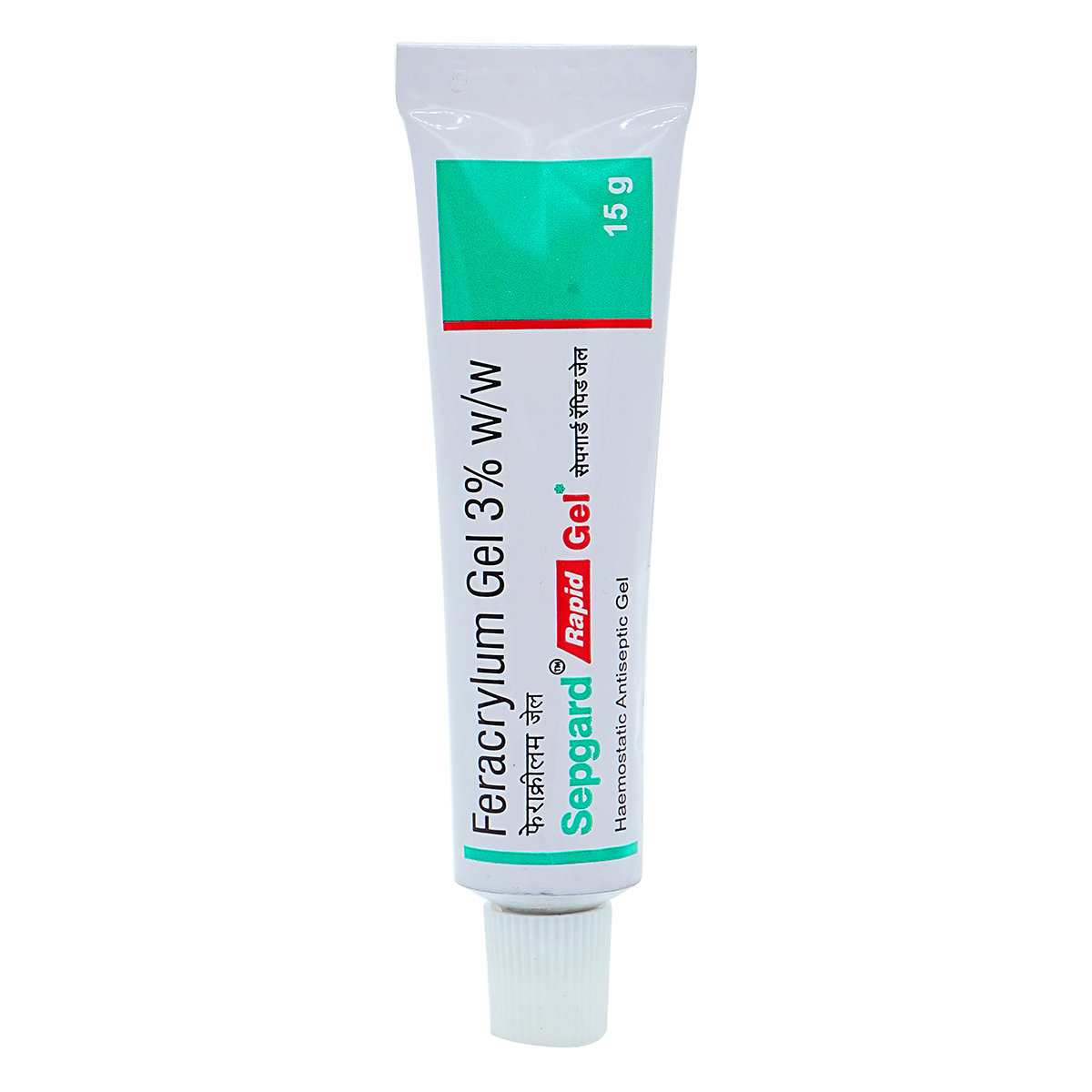
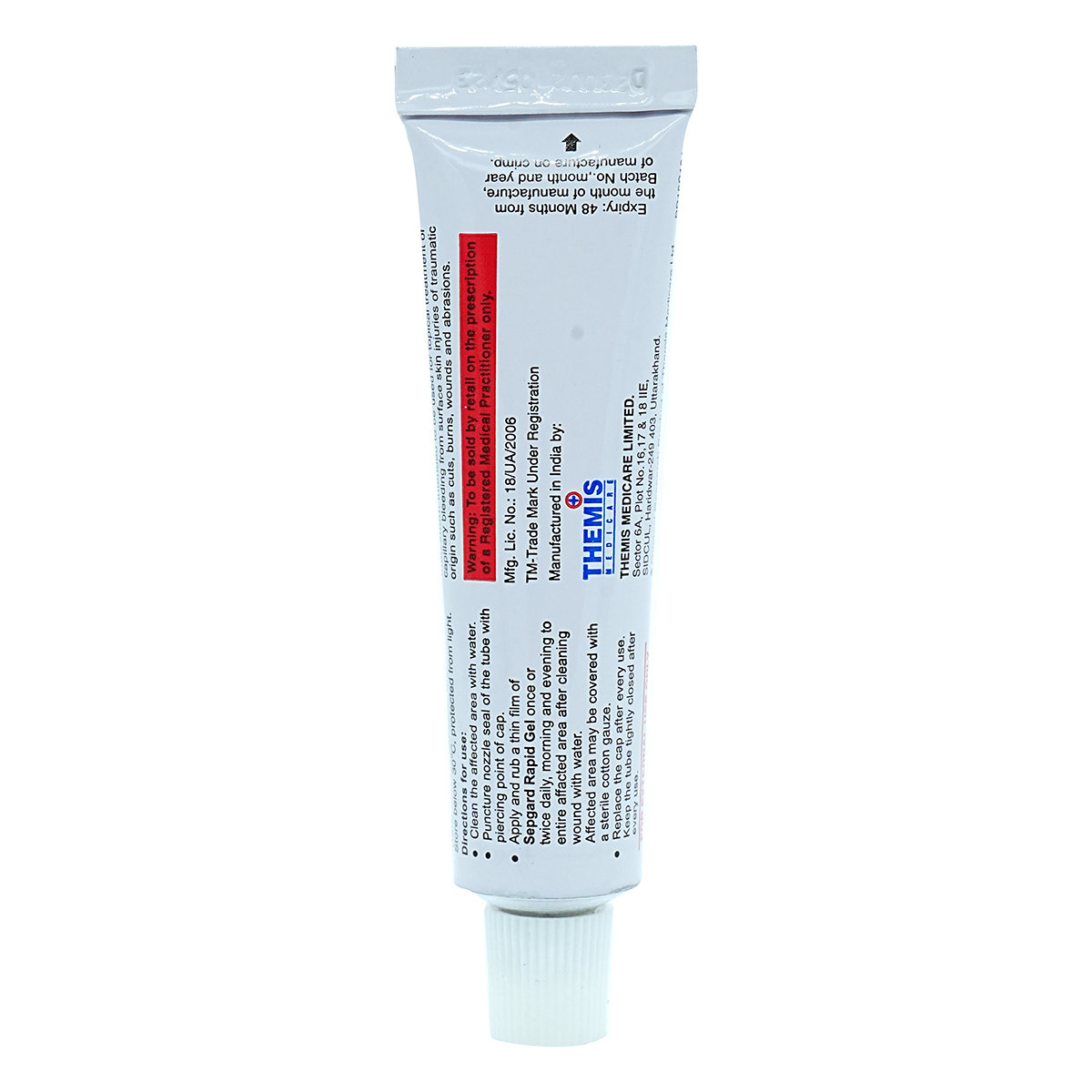
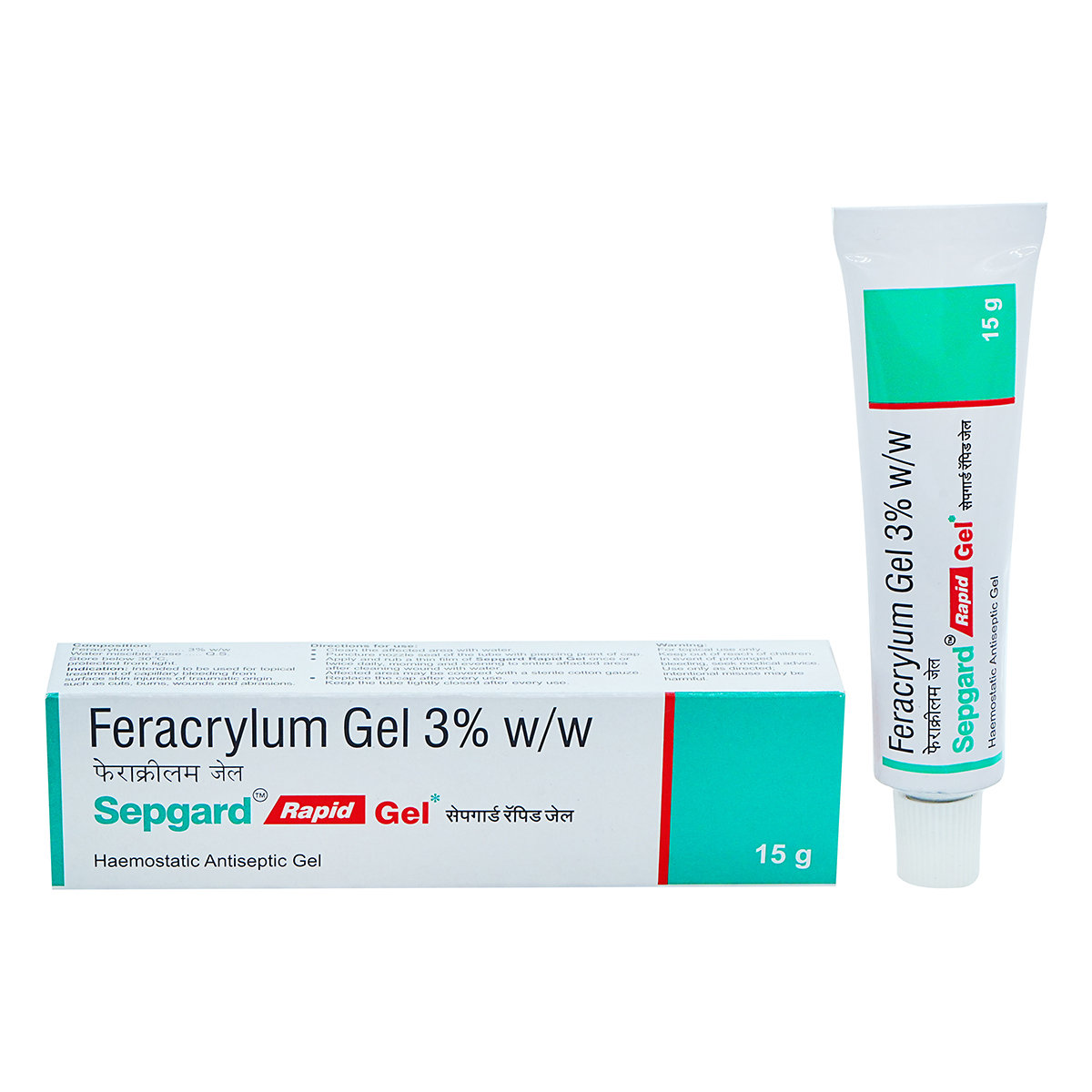
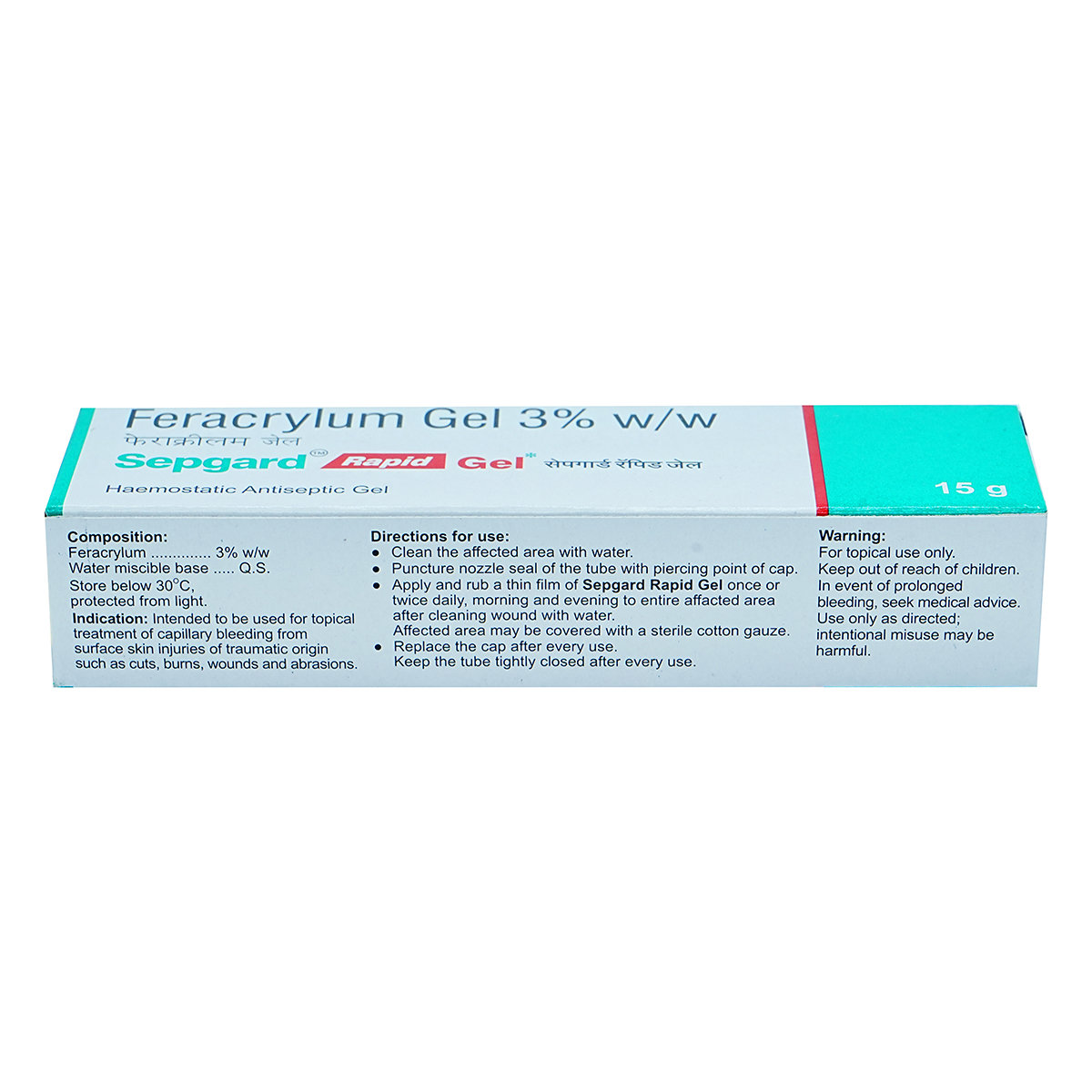
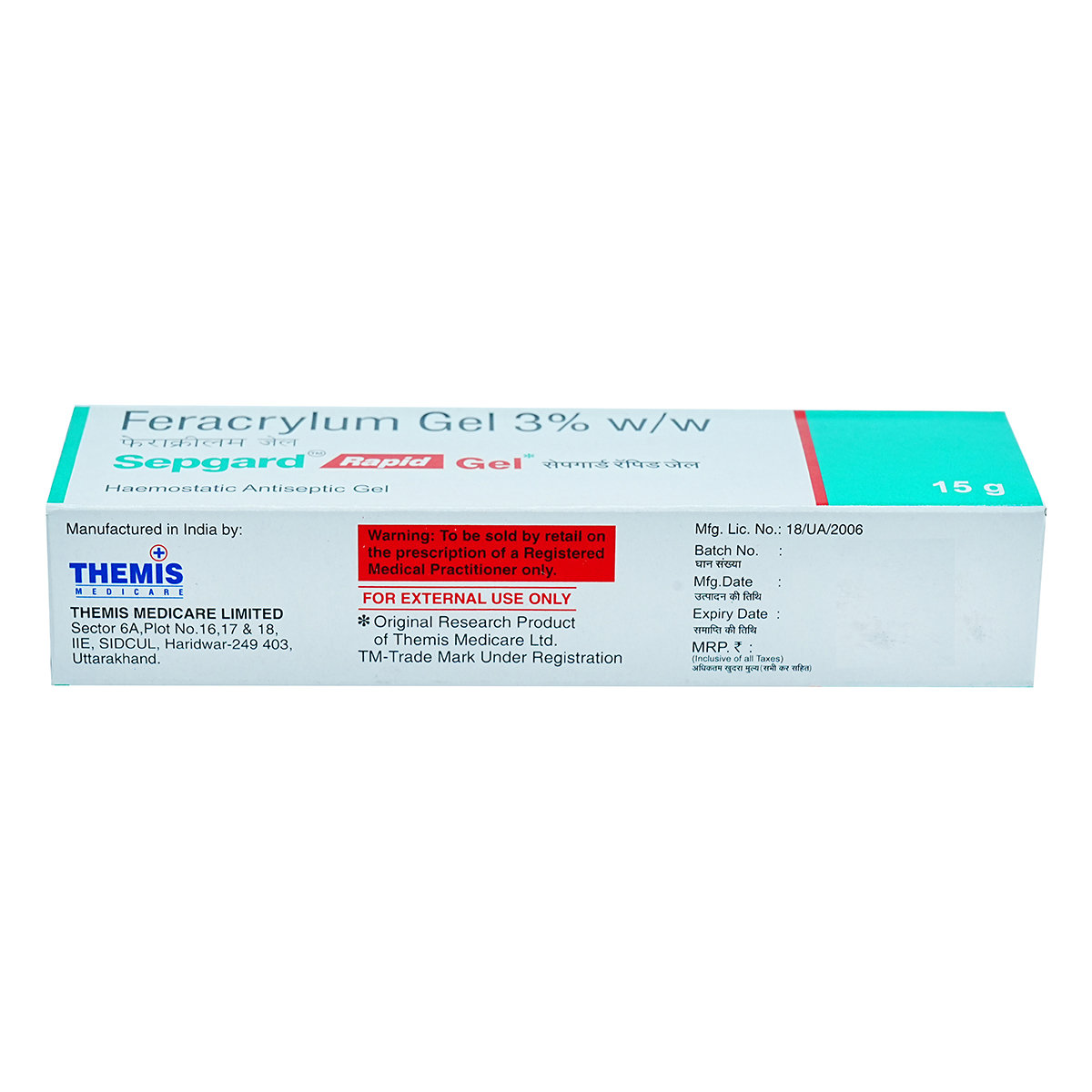
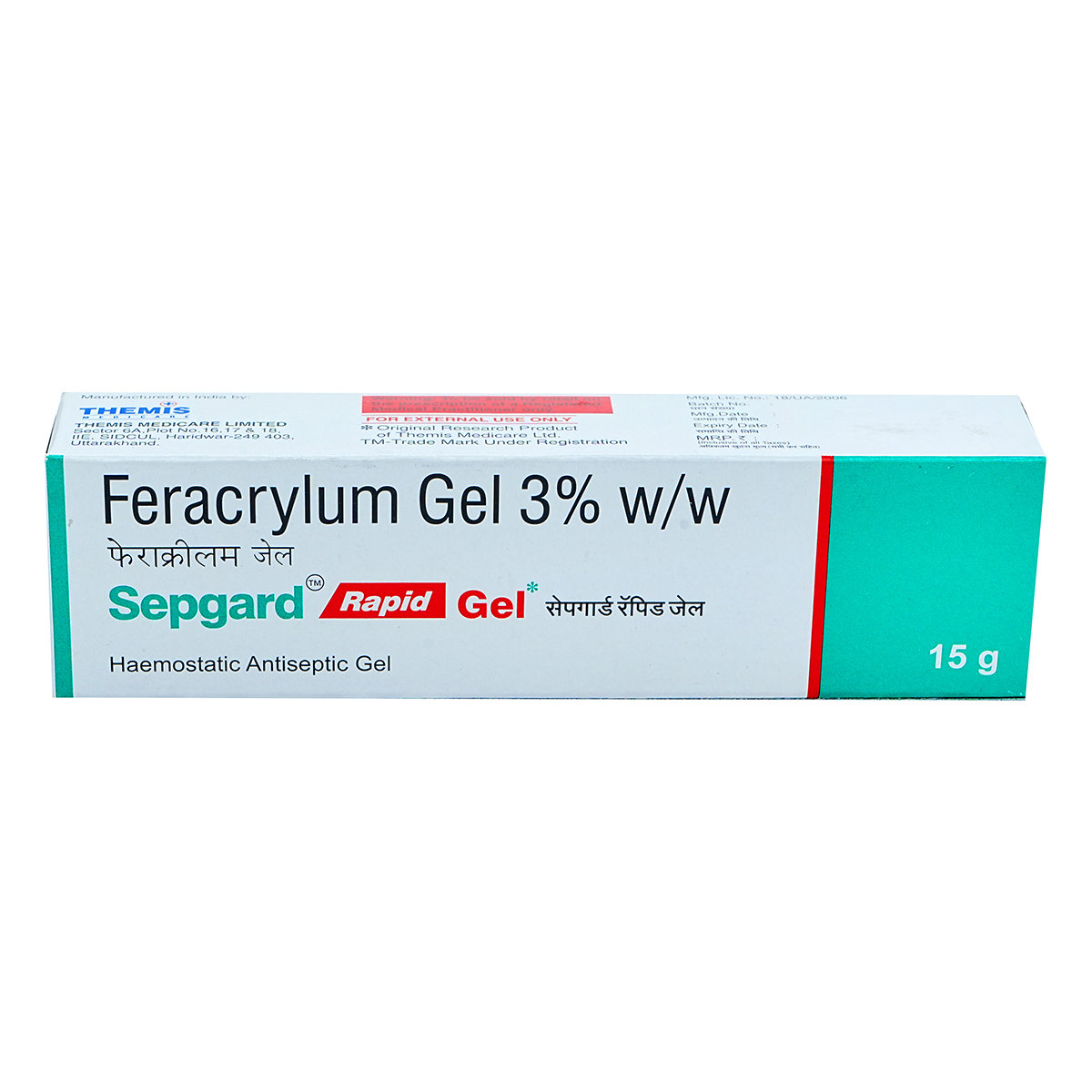






MRP ₹205
(Inclusive of all Taxes)
₹30.8 Cashback (15%)
Provide Delivery Location
Online payment accepted
 Prescription drug
Prescription drugWhats That
Composition :
Manufacturer/Marketer :
Consume Type :
Expires on or after :
Return Policy :
About Sepgard Rapid Gel
Sepgard Rapid Gel belongs to the class of ‘hemostatic agents’ (bleeding controlling) primarily used to treat bleeding from wounds and burns. It also acts as an antiseptic and prevents infection in post-operative wounds, cuts, burns, and abrasions.
Sepgard Rapid Gel contains ‘Feracrylum.’ It is a local hemostatic and topical antiseptic. It exerts antimicrobial action against gram-positive and gram-negative bacteria and fungi to prevent wound infection. It works by forming a complex with albumin protein and promotes clot formation to prevent bleeding.
Use Sepgard Rapid Gel as prescribed by your doctor. The common side effects of Sepgard Rapid Gel include a burning sensation and irritation at the application site. These side effects do not require medical attention and gradually resolve over time. However, if the side effects are persistent, reach out to your doctor.
Sepgard Rapid Gel is for topical (for skin) use only. Avoid contact with eyes and mouth. Let your doctor know if you are allergic to Sepgard Rapid Gel or have kidney/liver diseases before using. Sepgard Rapid Gel should be used during pregnancy and breastfeeding only if the doctor has prescribed it. It is advised to seek medical advice to limit/avoid alcohol consumption while using Sepgard Rapid Gel. This medicine usually does not affect your driving ability. Sepgard Rapid Gel should be used with caution in children only if the doctor has advised.
Uses of Sepgard Rapid Gel
Directions for Use
Key Benefits
Sepgard Rapid Gel is composed of Feracrylum, which is a local hemostatic and topical antiseptic agent. It works by forming a complex with albumin protein and promotes clot formation to prevent bleeding. It also has antimicrobial action and prevents infection in post-operative wounds, cuts, burns, and abrasions. It controls intra and post-operative oozing and ensures a clear field of vision. Feracrylum also aids in the healing of the bleeding surface and reduces the frequency of cauterization (heating the body tissues to prevent bleeding) and the need for blood transfusion.
Storage
Drug Warnings
Sepgard Rapid Gel is only for topical (for skin) use. Avoid contact with eyes and mouth. Before using Sepgard Rapid Gel, let your doctor know if you have a history of liver and kidney diseases or allergic reactions to Sepgard Rapid Gel. Inform your doctor beforehand if there is a risk of internal bleeding or blood disorder. Sepgard Rapid Gel is cautiously recommended for use during pregnancy and breastfeeding; however, please seek medical advice. It is advised to seek medical advice to limit/avoid alcohol consumption while using Sepgard Rapid Gel. This medicine usually does not affect your driving ability. Sepgard Rapid Gel should be used with caution in children only if the doctor has advised.
Diet & Lifestyle Advise
- Use mild soap while taking baths and prefer warm baths.
- Avoid harsh products on your skin.
- Do not scratch or pick your skin to avoid getting the affected area infected.
- Manage stress, eat healthily, drink plenty of water, exercise regularly, and get plenty of sleep.
Side Effects of Sepgard Rapid Gel
- Burning sensation
- Irritation at the application site
Habit Forming
Therapeutic Class
All Substitutes & Brand Comparisons
RX
Hemolock Rapid Gel 15 gm
Themis Pharmaceutical Ltd
₹169.5
(₹10.17/ 1gm)
17% CHEAPER
Product Substitutes
Author Details
We provide you with authentic, trustworthy and relevant information
FAQs
Sepgard Rapid Gel contains Feracrylum, a bleeding controlling agent. It enhances the formation of clots in the bleeding area and prevents further blood loss. It also acts as an antiseptic and prevents wound infection, and promotes its healing
Feracrylum is used to prevent the oozing of blood from capillaries and veins during surgeries. It is also used to manage post-operative wounds, cuts, burns, and abrasions to prevent infection.
Feracrylum is only for topical (for skin) use. Avoid contact with eyes and mouth. Diluted solution is not meant for intravenous or intramuscular use.
Sepgard Rapid Gel is contraindicated in patients with allergic reactions. It is also not intended to use in patients who take epsilon aminocaproic acid (EACA) for any bleeding disorders.
Drug-Drug Interactions Checker List
- AMINOCAPROIC ACID
Disease/Condition Glossary
Bleeding: It is the release of blood from a broken or damaged blood vessel. The blood vessel can be arteries, veins, and capillaries. It can occur externally or internally in organs. You can apply firm pressure for five minutes with a sterile bandage to prevent oozing for minor injuries. To prevent bleeding during surgeries or emergency bleeding, topical hemostatic agents and tissue adhesives are used.

Have a query?
Buy best Vascular System products by
Emcure Pharmaceuticals Ltd
Intas Pharmaceuticals Ltd
Lupin Ltd
Ozone Pharmaceuticals Ltd
Sun Pharmaceutical Industries Ltd
Cipla Ltd
Leeford Healthcare Ltd
Mercury Laboratories Ltd
Torrent Pharmaceuticals Ltd
FDC Ltd
Macleods Pharmaceuticals Ltd
Akumentis Healthcare Ltd
Dr Reddy's Laboratories Ltd
Indoco Remedies Ltd
Mankind Pharma Pvt Ltd
Oaknet Healthcare Pvt Ltd
Reliance Formulation Pvt Ltd
Samarth Life Sciences Pvt Ltd
Walter Bushnell
Wanbury Ltd
Abbott India Ltd
Eris Life Sciences Ltd
Galcare Pharmaceuticals Pvt Ltd
Juggat Pharma Ltd
Knoll Pharmaceuticals Ltd
Kontest Pharmaceuticals
Saf Fermion Ltd
Serdia Pharmaceuticals India Pvt Ltd
Systopic Laboratories Pvt Ltd
Themis Chemicals Ltd
Akcent Healthcare India Pvt Ltd
Alembic Pharmaceuticals Ltd
Amelia Healthcare Pvt Ltd
Canixa Life Sciences Pvt Ltd
East West Pharma India Pvt Ltd
German Remedies Ltd
Glenmark Pharmaceuticals Ltd
Ipca Laboratories Ltd
La Pristine Bioceuticals Pvt Ltd
Morepen Laboratories Ltd
Nexgen Rx Life Science Pvt Ltd
Pfizer Ltd
Rapross Pharmaceuticals Pvt Ltd
Sumac Pharma Pvt Ltd
Theia Health Care Pvt Ltd
Themis Medicare Ltd
Themis Pharmaceutical Ltd
4Care Lifesciences Pvt Ltd
Aar Ess Remedies Pvt Ltd
Aarux Pharmaceuticals Pvt Ltd
Alna Biotech Pvt Ltd
Aphia Healthcare
Aristo Pharmaceuticals Pvt Ltd
Baxter India Pvt Ltd
Bennet Pharmaceuticals Ltd
Bharat Serums and Vaccines Ltd
Biosys Pharmaceuticals Ltd
Bros Enterprises Ltd
Celebrity Biopharma Ltd
Chemo Healthcare Pvt Ltd
Cibeles Pharmaceuticals Pvt Ltd
Comed Chemicals Ltd
Conatus Healthcare Pvt Ltd
Cresha Lifesciences
Cute Care Life Sciences Pvt Ltd
Elbrit Life Sciences Pvt Ltd
Euro Biogenics
Icon Life Sciences
J B Chemicals & Pharmaceuticals Ltd
Kee Pharma Ltd
Kemiq Lifesciences Pvt Ltd
Kivi Labs Ltd
Lincoln Pharmaceuticals Ltd
Medchronic Health Care
Medgen Drugs And Laboratories Pvt Ltd
Megma Healthcare Pvt Ltd
Novartis India Ltd
Olcare Laboratories Pvt Ltd
Ornate Labs Pvt Ltd
Q Check Pharmaceuticals
Saan Labs
Stadmed Pvt Ltd
Std Pharmaceuticals Pvt Ltd
Zydus Cadila
3G Life Sciences
Accent Pharmaceuticals & Diagnostics
Adroit Biomed Ltd
Aishwarya Healthcare
Ajanta Pharma Ltd
Akesiss Pharma Pvt Ltd
Albert David Ltd
Algen Healthcare Ltd
Amazone Pharmaceuticals Pvt Ltd
Amstel Pharma Pvt Ltd
Anhox Healthcare Pvt Ltd
Apios Lifesciences Pvt Ltd
Args India Pharma Pvt Ltd
Ark Life Science Pvt Ltd
Arvincare
Aztomax Biotech
Alcohol
Safe if prescribed
There are no notable interactions with alcohol consumption. However, please limit alcohol intake and consult your doctor.
Pregnancy
Consult your doctor
Sepgard Rapid Gel should be used with caution during pregnancy. Please consult your doctor if you are planning to become pregnant or already pregnant before starting Sepgard Rapid Gel.
Breast Feeding
Consult your doctor
There is limited data on how Sepgard Rapid Gel affects breastfeeding. Please consult your doctor before starting Sepgard Rapid Gel.
Driving
Safe if prescribed
Sepgard Rapid Gel is probably safe to use and does not affect your driving ability.
Liver
Consult your doctor
Let your doctor know if you have any history of liver diseases or hepatic impairment. Your doctor will weigh the benefits and potential risks before prescribing Sepgard Rapid Gel.
Kidney
Consult your doctor
Let your doctor know if you have any history of kidney diseases. Your doctor will weigh the benefits and potential risks before prescribing Sepgard Rapid Gel.
Children
Safe if prescribed
Sepgard Rapid Gel is cautiously recommended in children only if the doctor has prescribed it.





